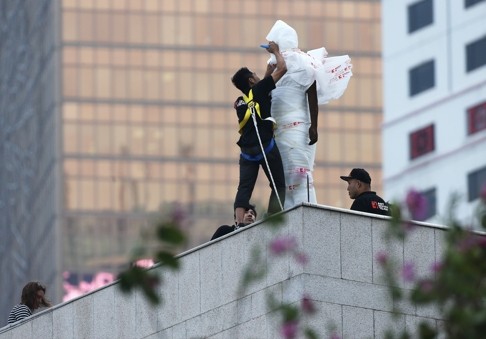Beware the unanticipated view of Antony Gormley’s Event Horizon
Eric Caine says if the art installation serves as a stimulus for discussion about suicide, depression and opportunities for leading a fulfilling life, then the benefits will outweigh any risk of unintended consequences

The creator of the art installation Event Horizon, Antony Gormley, notes that “…these still and silent bodies look out into space, asking where the human project fits in the scheme of things”. And Robert Ness, director of the British Council Hong Kong, declares: “When we look up at or pass by the sculptures, it encourages us to stop, engage, and perhaps reassess our current position in the world by looking within ourselves.”
We will also see figures standing on the edge of buildings in a city where 500 or more people die annually by jumping to their deaths
No doubt, art should be engaging, stimulating and provocative. It should challenge us to search both within and around ourselves, to question where we fit in society, and indeed, within a larger cosmic perspective.
An event horizon is said to be the boundary of a black hole, and by its very nature, no light emerges and we cannot see what lies ahead. Thus, this display in Hong Kong will prod us to look inside, yet also invite us to gaze far beyond. But we will also see figures standing on the edge of buildings in a city where 500 or more people die annually by jumping to their deaths.

READ MORE: ‘Naked Man’ sculptures on Hong Kong’s rooftops spark calls to police after they’re mistaken for suicide attempts
Among the thousands in Hong Kong who may see Event Horizon, how many may take its message to heart in a fashion its installers never intended?
Art is an essential part of human existence. It should not be muffled and I would never suggest stifling this display. But what about the relatively rare instances of a few vulnerable, alone, unsupported and deeply distressed people seeing this as an invitation or suggestion to jump into space?
So, I would ask: What safety precautions are being taken? Will the challenges posed provide an opportunity to discuss the personal turmoil and sadness that comes before suicide, and the opportunities for a vibrant, fulfilling life? Will it also serve as a stimulus to prompt those of us who have experienced good fortune to share the benefits? If Event Horizon serves as that kind of stimulus, the inherent risks will be far outweighed by its benefits.
Eric D. Caine, M.D, is John Romano Professor and chair in the Department of Psychiatry, and director of the Injury Control Research Centre for Suicide Prevention, at the University of Rochester Medical Centre, US. [email protected]